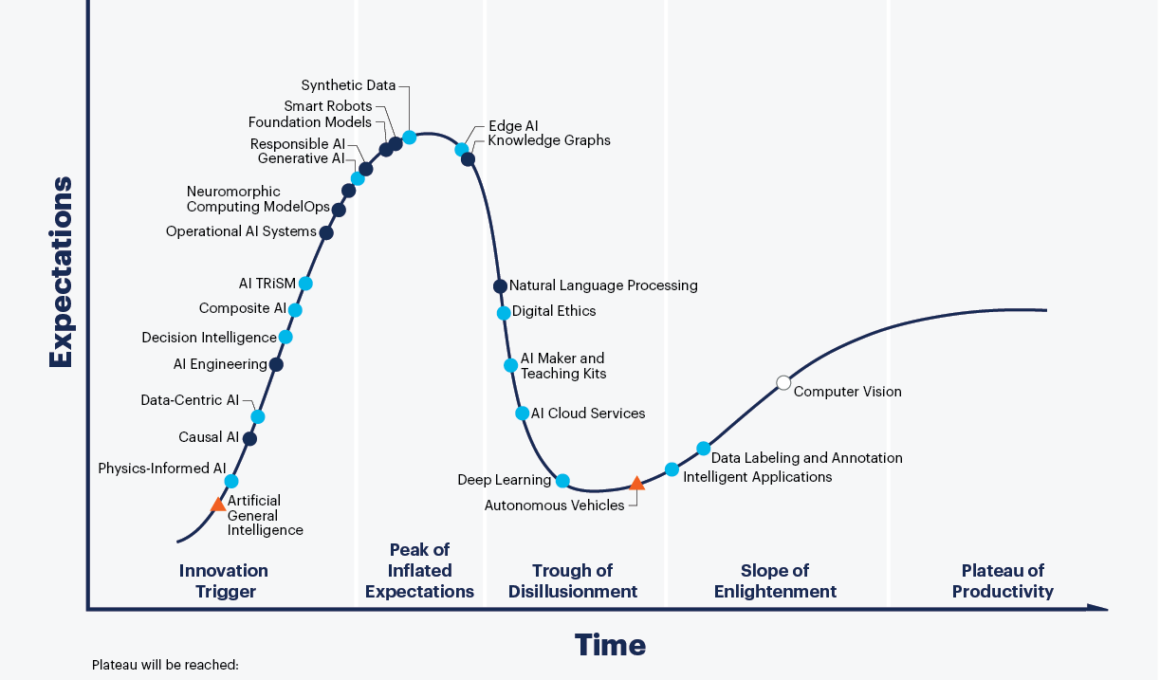Gartner
Jackie Wiles
September 15, 2022
Executive Summary by:
Joaquim Cardoso MSc
health transformation institute (HTI)
October 17, 2022
AI innovations continue to deliver big benefits to business and adoption rates will accelerate in coming years
The 2022 Gartner Hype Cycle™ for Artificial Intelligence features “must-know” innovations expected to drive extensive benefits to any organization.
- These innovations go beyond everyday AI techniques already being used to add intelligence to previously static business applications, devices and productivity tools.
- Pay early attention to innovations expected to hit mainstream adoption in two to five years, including composite AI, decision intelligence and edge AI.
The AI innovations on the Hype Cycle reflect complementary and sometimes conflicting priorities across four main categories:
- Data-centric AI
- Model-centric AI
- Applications-centric AI
- Human-centric AI
Early adoption of these innovations can drive significant competitive advantage and business value and ease problems associated with the fragility of AI models.”
ORIGINAL PUBLICATION (full version)

AI innovations continue to deliver big benefits to business and adoption rates will accelerate in coming years. See the outlook and impact.
The 2022 Gartner Hype Cycle™ for Artificial Intelligence (AI) identifies must-know innovations in AI technology and techniques that go beyond the everyday AI already being used to add intelligence to previously static business applications, devices and productivity tools.
“Notably, the AI Hype Cycle is full of innovations expected to drive high or even transformational benefits,” says Afraz Jaffri, Director Analyst at Gartner.
“Pay particular attention to innovations expected to hit mainstream adoption in two to five years, including composite AI, decision intelligence and edge AI.
Early adoption of these innovations can drive significant competitive advantage and business value and ease problems associated with the fragility of AI models.”
AI innovations fall into four categories
The wide range of AI innovations is expected to impact people and processes within and outside an enterprise context, making them important to understand for many stakeholders, from business leaders to the enterprise engineering teams tasked with deploying and operationalizing AI systems.
Data and analytics (D&A) leaders have the most to gain, however, from using the Hype Cycle outlook to craft their AI strategies for the future and use technologies that offer high impact in the present.
The AI innovations on the Hype Cycle reflect complementary and sometimes conflicting priorities across four main categories:
- Data-centric AI
- Model-centric AI
- Applications-centric AI
- Human-centric AI

1.Data-centric AI
The AI community has traditionally focused on improving outcomes from AI solutions by tweaking the AI models themselves, but data-centric AI shifts the focus toward enhancing and enriching the data used to train the algorithms.
The AI community has traditionally focused on improving outcomes from AI solutions by tweaking the AI models themselves, but data-centric AI shifts the focus toward enhancing and enriching the data used to train the algorithms.
In addressing AI-specific data considerations, data-centric AI disrupts traditional data management, but organizations that invest in AI at scale will evolve to preserve evergreen classical data-management ideas and extend them to AI in two ways:
- Add capabilities necessary for convenient AI development by an AI-focused audience that is not familiar with data management.
- Use AI to improve and augment evergreen classics of data governance, persistence, integration and data quality.
Innovations in data-centric AI include synthetic data, knowledge graphs, data labeling and annotation.
Innovations in data-centric AI include synthetic data, knowledge graphs, data labeling and annotation.
Synthetic data, for example, is a class of data that is artificially generated rather than obtained from direct observations of the real world.
Data can be generated using different methods, such as statistically rigorous sampling from real data, semantic approaches and generative adversarial networks or by creating simulation scenarios where models and processes interact to create completely new datasets of events.
Adoption is increasing across various industries, along with use in computer vision and natural language applications, but Gartner predicts a massive increase in adoption as synthetic data:
- Avoids using personally identifiable information when training machine learning (ML) models via synthetic variations of original data or synthetic replacement of parts of data
- Reduces cost and saves time in ML development as it is cheaper and faster to obtain
- Improves ML performance as more training data leads to better training outcomes
Adoption is increasing across various industries, along with use in computer vision and natural language applications, but Gartner predicts a massive increase in adoption as synthetic data:

2.Model-centric AI
Despite the shift to a data-centric approach, AI models still need attention to ensure the outputs continue to help us to take better actions.
Innovations here include physics-informed AI, composite AI, causal AI, generative AI, foundation models and deep learning.
Despite the shift to a data-centric approach, AI models still need attention to ensure the outputs continue to help us to take better actions.
Innovations here include physics-informed AI, composite AI, causal AI, generative AI, foundation models and deep learning.
Composite AI refers to the fusion of different AI techniques to improve the efficiency of learning and broaden the level of knowledge representations.
Since no single AI technique is a silver bullet, composite AI ultimately provides a platform to solve a wider range of business problems in a more effective manner.
Expected to reach mainstream adoption in two to five years, the business benefits of composite AI are likely to be transformational, enabling new ways of doing business across industries that will result in major shifts in industry dynamics.
For example, composite AI:
- Brings the power of AI to a broader group of organizations that do not have access to large amounts of historical or labeled data but have significant human expertise
- Helps to expand the scope and quality of AI applications (that is, more types of reasoning challenges can be embedded)
Causal AI includes different techniques, like causal graphs and simulation, that help uncover causal relationships to improve decision making.
Though it will take 5 to 10 years for causal AI to reach mainstream adoption, the business benefits are expected to be high — enabling new ways of performing horizontal or vertical processes that will result in significantly increased revenue or cost savings for an enterprise.
Causal AI benefits include:
- Efficiencies from adding domain-knowledge to bootstrap causal AI models with smaller datasets
- Greater decision augmentation and autonomy in AI systems
- Better explainability by capturing easy-to-interpret cause-and-effect relationships
- More robustness and adaptability by leveraging causal relationships that remain valid in changing environments
- Reduced bias in AI systems by making causal links more explicit

3.Applications-centric AI
Innovations here include AI engineering, decision intelligence, operational AI systems, ModelOps, AI cloud services, smart robots, natural language processing (NLP), autonomous vehicles, intelligent applications and computer vision.
Decision intelligence and edge AI are both expected to reach mainstream adoption in two to five years and have transformational business benefits.
Decision intelligence is a practical discipline used to improve decision making by explicitly understanding and engineering how decisions are made and how outcomes are evaluated, managed and improved via feedback.
Decision intelligence helps to:
- Reduce technical debt and increase visibility, and improve the impact of business processes by materially enhancing the sustainability of organizations’ decision models based on the power of their relevance and the quality of their transparency, making decisions more transparent and auditable
- Reduce the unpredictability of decision outcomes by properly capturing and accounting for the uncertainty factors in the business context and making decision models more resilient
Edge AI refers to the use of AI techniques embedded in Internet of Things (IoT) endpoints, gateways and edge servers, in applications ranging from autonomous vehicles to streaming analytics.
Business benefits include:
- Improved operational efficiency, such as manufacturing visual inspection systems
- Enhanced customer experience
- Reduced latency in decision making, with the use of local analytics
- Connectivity cost reduction, with less data traffic between the edge and the cloud
- Persistent solution availability, irrespective of network connectivity

4.Human-centric AI
This group of innovations includes AI trust, risk and security management (TRiSM), responsible AI, digital ethics, and AI maker and teaching kits.
When AI replaces human decisions, it amplifies good and bad outcomes alike.
Responsible AI enables the right outcomes by resolving dilemmas rooted in delivering value versus tolerating risks.
Responsible AI is an umbrella term for aspects of making appropriate business and ethical choices when adopting AI, including business and societal value, risk, trust, transparency, fairness, bias mitigation, explainability, accountability, safety, privacy and regulatory compliance.
Responsible AI will take 5 to 10 years to reach mainstream adoption but will ultimately have a transformational impact on business.
Responsible AI is an umbrella term for aspects of making appropriate business and ethical choices when adopting AI …
Digital ethics are a nearer-term trend (two to five years) likely to have a high business impact.
Digital ethics comprise the systems of values and moral principles for the conduct of electronic interactions among people, organizations and things.
These issues, especially as they relate to privacy and bias, remain of concern to many.
People, increasingly aware that their information is valuable, are frustrated by lack of transparency, misuse and breaches.
Organizations are acting to mitigate risks around managing and securing personal data, while governments are implementing stricter legislation.
Digital ethics comprise the systems of values and moral principles for the conduct of electronic interactions among people, organizations and things.
Many organizations still ignore digital ethics, because they think it doesn’t apply to their industry or domain, but Gartner predicts that by 2024, 30% of major organizations will use a new “voice of society” metric to act on societal issues and assess the impact on their business performance.
Organizations will need to integrate digital ethics into their AI strategies to bolster their influence and reputation among customers, employees, partners and society.
Many organizations still ignore digital ethics, because they think it doesn’t apply to their industry or domain, but Gartner predicts that by 2024, 30% of major organizations will use a new “voice of society” metric …
About the author:
Afraz Jaffri is a Research Director at Gartner, where Mr. Jaffri focuses on Analytics, Data Science and AI.
He advises Data and Analytics leaders on making the most from their investments in modern data science, machine learning and analytics platforms.
Originally published at https://www.gartner.com.












